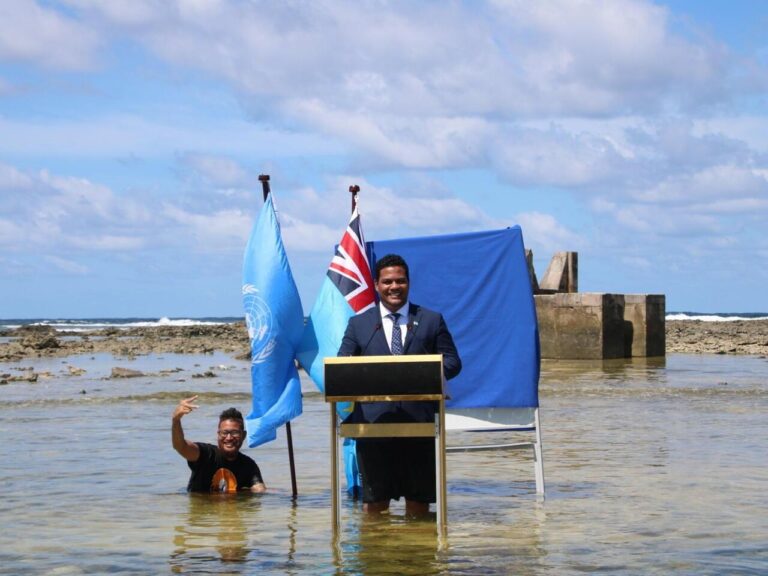Tuvalu, one of the world’s smallest island nations, faces an existential threat as rising sea levels driven by climate change inch closer to swallowing its homeland. In the latest episode of Monocle’s “Explainer” series, titled “Tuvalu’s Climate-Change Escape to Australia,” the focus shifts to the urgent steps being taken by Tuvaluans to safeguard their future beyond their shrinking shores. This report delves into the logistical, political, and human dimensions of Tuvalu’s unprecedented migration plans, highlighting the broader implications for climate refugees worldwide.
Tuvalu’s Climate Crisis and the Urgent Need for Relocation Planning
Rising sea levels are rapidly swallowing Tuvalu’s low-lying lands, threatening not only physical territory but the cultural identity of its 11,000 inhabitants. The once-remote island nation is now at the forefront of the climate crisis, as saltwater intrusion destroys arable land and freshwater reserves become scarcer by the year. With less than 3 meters average elevation above sea level, Tuvalu faces an existential challenge-forcing its government to seek international partnerships focused on planned relocation. Australia, due to its geographic proximity and historic ties, has emerged as a preferred destination, sparking debates about migration policies, humanitarian responsibility, and the preservation of Tuvaluan heritage abroad.
Key challenges driving relocation planning include:
- Environmental degradation accelerating displacement
- Legal frameworks for climate refugees still underdeveloped
- Socioeconomic integration and cultural preservation abroad
- Funding and logistical coordination between governments
To visualize the urgency and projected impacts, the following table outlines anticipated sea-level rise against Tuvalu’s habitable land area over the next three decades:
| Year | Projected Sea-Level Rise (cm) | Habitable Land Area (sq km) | Population at Risk (%) |
|---|---|---|---|
| 2025 | 8 | 26 | 30% |
| 2035 | 15 | 22 | 55% |
| 2045 | 25 | 15 | 80% |
Without swift action, Tuvalu’s fate will serve as a stark warning for other island nations. The current dialogues highlight that relocation is not merely a question of survival, but also a test of global solidarity and long-term climate justice.
Australia’s Role in Offering Safe Haven Amid Rising Sea Levels
Australia’s commitment to providing refuge for communities displaced by rising sea levels has become a pivotal aspect of its humanitarian and environmental agenda. As Pacific island nations like Tuvalu face existential threats from climate change, Australia has begun to shape policies that facilitate migration pathways, offering a chance for affected populations to start anew. These initiatives encompass not only visa reforms but also collaborative efforts with Pacific governments to ensure that relocations are conducted with dignity and foresight. The policy framework highlights:
- Targeted visa schemes tailored for climate-impacted residents
- Joint environmental monitoring programs with affected island nations
- Community integration support focusing on cultural preservation and economic inclusion
Despite these advancements, challenges remain in balancing national interests with humanitarian responsibilities. Critics argue that Australia’s response needs to be more ambitious given the accelerating pace of climate impact. Meanwhile, grassroots organizations play a crucial role in advocating for the rights of Pacific Islanders seeking safe haven. The evolving situation underscores an urgent need for frameworks that not only facilitate migration but also support long-term climate resilience both within Australia and across the Pacific region.
| Program | Purpose | Current Status |
|---|---|---|
| Pacific Climate Resettlement Visa | Facilitate migration for affected islanders | In pilot phase |
| Joint Environmental Monitoring | Track sea level changes and respond proactively | Active since 2022 |
| Community Integration Grants | Support social and economic inclusion | Ongoing |
Policy Recommendations for Strengthening Pacific Islander Migration Support
Enhancing legal frameworks is essential for equipping Australia and neighbouring Pacific nations to handle increased migration pressures driven by climate change. Policies should expand humanitarian visa categories specifically tailored for climate-displaced Pacific Islanders, ensuring swift, streamlined processing. Additionally, bilateral agreements need updating to provide Pacific Islander migrants with clearer pathways to permanent residency and work rights, minimizing uncertainty and exploitation. Stakeholders must prioritize culturally sensitive protection measures and support services, recognizing the unique challenges these communities face in displacement.
Investment in community integration and resilience programs will also prove vital. This includes expanding language assistance, mental health support, and employment training targeted at Pacific Islander migrants. Collaborative partnerships between governments, NGOs, and diaspora networks can foster social cohesion and build capacity within host communities. Below is a concise overview of key policy priorities:
| Policy Focus | Recommended Measures |
|---|---|
| Legal Protections | Climate-focused humanitarian visas, streamlined applications |
| Residency Pathways | Bilateral migration agreements, permanent residency options |
| Community Support | Language, mental health, and employment programs |
| Cultural Sensitivity | Training for service providers, diaspora engagement |
Key Takeaways
As Tuvalu confronts the escalating threats of climate change, its proactive engagement with Australia highlights a critical chapter in climate diplomacy and human resilience. The unfolding dynamics between this small island nation and its regional neighbor underscore the urgent need for innovative solutions to displacement and survival in an increasingly unstable world. “Explainer 474” not only sheds light on Tuvalu’s strategic response but also prompts wider reflection on the responsibilities shared by the international community in addressing climate-induced migration.




